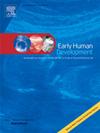极早产儿或极早产儿视觉定向功能的发展轨迹
IF 2
3区 医学
Q2 OBSTETRICS & GYNECOLOGY
引用次数: 0
摘要
背景和目的早产会增加神经发育障碍的风险,如影响视觉处理的脑性视觉障碍(CVI)。评估幼儿视觉功能的传统方法往往依赖于语言/运动反应,具有挑战性。本研究的目的是利用眼动追踪技术研究2 ~ 5岁矫正年龄(CA)的极早产儿(32周胎龄)视觉定向功能(VOF)的发展轨迹。方法对263名早产儿在出生后2岁、3岁和5岁时进行眼动追踪。49名早产儿接受了所有三项测量。出生后不久进行核磁共振成像(MRI),并使用改进的Kidokoro评分方案评估脑损伤。将早产儿组的高(卡通和对比)和中等(形式和运动检测)显著视觉刺激的VOF结果与足月出生同龄人的VOF结果进行比较。结果约40%的早产儿在高、中显著性刺激下VOF发育正常。然而,在另外40%的早产儿童中,在出生后5岁时发现高显著性刺激导致的视觉处理延迟增加。出生后不久的MRI脑损伤与5岁时异常的VOF之间没有明显的相关性。结论:数据表明,使用高显著性刺激进行常规视觉筛查可以识别有脑损伤风险的儿童从2岁起的VOF延迟。早期发现视觉处理缺陷可以对学龄前儿童进行及时干预和专门护理。本文章由计算机程序翻译,如有差异,请以英文原文为准。
Developmental trajectories of visual orienting functions in children born very or extremely preterm
Background and aims
Preterm birth increases the risk of neurodevelopmental impairments, such as Cerebral Visual Impairment (CVI), which affects visual processing. Assessing visual functions in young children is challenging with traditional methods that often rely on verbal/motor responses. The aim of the study was to investigate the developmental trajectories of Visual Orienting Functions (VOF) in children born very preterm (<32 weeks gestational age) between 2 and 5 years corrected age (CA) using eye tracking.
Methods
263 children born preterm underwent eye tracking at 2, 3 and 5 years CA. A subgroup of 49 children underwent all three measurements. Magnetic resonance imaging (MRI) was performed shortly after birth and evaluated for brain damage using a modified Kidokoro scoring protocol. The VOF results to high (cartoon and contrast) and intermediate (form and motion detection) salient visual stimuli of the preterm group were compared to those of term-born age-matched peers.
Results
Approximately 40 % of children born preterm showed normal VOF development to high and intermediate salient stimuli. However, in another 40 % of children born preterm, an increase in delayed visual processing to high-salient stimuli was found at 5 years CA. No significant correlation was found between brain damage on MRI shortly after birth and abnormal VOF at 5 years CA.
Conclusion
The data suggest that routine visual screening using high-salient stimuli can identify VOF delays from 2 years CA onwards in children at risk of brain damage. Early detection of visual processing deficits can enable timely interventions and specialized care for pre-schoolers.
求助全文
通过发布文献求助,成功后即可免费获取论文全文。
去求助
来源期刊

Early human development
医学-妇产科学
CiteScore
4.40
自引率
4.00%
发文量
100
审稿时长
46 days
期刊介绍:
Established as an authoritative, highly cited voice on early human development, Early Human Development provides a unique opportunity for researchers and clinicians to bridge the communication gap between disciplines. Creating a forum for the productive exchange of ideas concerning early human growth and development, the journal publishes original research and clinical papers with particular emphasis on the continuum between fetal life and the perinatal period; aspects of postnatal growth influenced by early events; and the safeguarding of the quality of human survival.
The first comprehensive and interdisciplinary journal in this area of growing importance, Early Human Development offers pertinent contributions to the following subject areas:
Fetology; perinatology; pediatrics; growth and development; obstetrics; reproduction and fertility; epidemiology; behavioural sciences; nutrition and metabolism; teratology; neurology; brain biology; developmental psychology and screening.
 求助内容:
求助内容: 应助结果提醒方式:
应助结果提醒方式:


